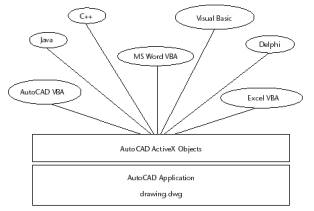|
This
introduction describes the concept of exposing AutoCAD®
objects through an ActiveX® interface and programming
those objects using the Visual Basic® for Applications
programming environment. Also included is an
introduction to all the documentation and sample code
provided for AutoCAD ActiveX and VBA.
Overview
of AutoCAD ActiveX Technology
AutoCAD
ActiveX provides a mechanism to manipulate AutoCAD
programmatically from within or outside AutoCAD. It does
this by exposing AutoCAD objects to the "outside
world." Once these objects are exposed, they can be
accessed by many different programming languages and
environments and by other applications such as Microsoft®
Word VBA or Excel VBA.

There
are two advantages to implementing an ActiveX interface
for AutoCAD:
Programmatic
access to AutoCAD drawings is opened up to many more
programming environments. Before ActiveX Automation,
developers were limited to an AutoLISP or C++ interface.
Sharing
data with other Windows® applications, such as
Microsoft Excel® and Word®, is made dramatically
easier.
OVERVIEW
OF AUTOCAD ACTIVEX OBJECTS
An
object is the main building block of any ActiveX
application. Each exposed object represents a precise
part of AutoCAD. There are many different types of
objects in the AutoCAD ActiveX interface. For example
Graphical
objects such as lines, arcs, text, and dimensions are
objects
-
Style
settings such as linetypes and dimension styles are
objects
-
Organizational
structures such as layers, groups, and blocks are
objects
-
The
drawing displays such as view and viewport are
objects
-
Even
the drawing and the AutoCAD application are
considered objects
Overview
of AutoCAD Visual Basic for Applications (VBA) Interface
Microsoft
VBA is an object-oriented programming environment
designed to provide rich development capabilities
similar to those of Visual Basic (VB). The main
difference between VBA and VB is that VBA runs in the
same process space as AutoCAD, providing an
AutoCAD-intelligent and very fast programming
environment.
VBA
also provides application integration with other
VBA-enabled applications. Which means AutoCAD, using
other application object libraries, can be an Automation
controller for other applications such as Microsoft Word
or Excel.
The
standalone development editions of Visual Basic, which
must be purchased separately, complement AutoCAD VBA
with additional components, such as an external database
engine and report-writing capabilities.
here
are four advantages to implementing VBA for AutoCAD:
The
Visual Basic programming environment is easy to learn
and use.
-
VBA
runs in-process with AutoCAD. This translates to
very fast program execution.
-
Dialog
construction is quick and effective. This allows
developers to prototype applications and quickly
receive feedback on designs.
-
Projects
can be standalone or imbedded in drawings. This
choice allows developers great flexibility in the
distribution of their applications.
HOW
VBA IS IMPLEMENTED IN AUTOCAD
VBA
sends messages to AutoCAD by the AutoCAD ActiveX
Automation interface. AutoCAD VBA permits the VBA
environment to run simultaneously with AutoCAD and
provides programmatic control of AutoCAD through the
ActiveX Automation interface. This coupling of AutoCAD,
ActiveX Automation, and VBA provides an extremely
powerful interface not only for manipulating AutoCAD
objects, but for sending data to or retrieving data from
other applications.
There
are three fundamental elements that define ActiveX and
VBA programming in AutoCAD. The first is AutoCAD itself,
which has a rich set of objects that encapsulates
AutoCAD entities, data, and commands. Because AutoCAD
was designed as an open-architecture application with
multiple levels of interface, familiarity with AutoCAD
programmability is highly desirable in order to use VBA
effectively. If you've used AutoLISP® to control
AutoCAD programmatically, you already have a good
understanding of the AutoCAD facilities. However, you
will find the VBA object-based approach to be quite
different from that of Visual LISP®.
The
second element is the AutoCAD ActiveX Automation
interface, which establishes messages (communication)
with AutoCAD objects. Programming in VBA requires a
fundamental understanding of ActiveX Automation. A
description of the AutoCAD ActiveX Automation interface
can be found in the ActiveX and VBA Reference. Even the
experienced VB programmer will find the AutoCAD ActiveX
Automation interface invaluable for understanding and
developing AutoCAD VBA applications.
The
third element is the VBA programming environment which
has its own set of objects, keywords, constants, and so
forth that provides program flow, control, debugging,
and execution. Microsoft's own extensive online help for
VBA is included with the AutoCAD VBA and is accessible
from the VBA IDE by any of the following methods:
Pressing
F1 on the keyboard
DEPENDENCIES
AND RESTRICTIONS WHEN USING AUTOCAD VBA
To
ensure the proper functionality of AutoCAD ActiveX and
VBA you must comply with the following system
dependencies:
Windows
NT® 4.0
It
is highly recommended that Service Pack 3 for Windows NT
4.0 be installed to run AutoCAD ActiveX and VBA.
Windows®
95, or Windows 98
No
special requirements from Microsoft.
Installing,
Reinstalling, or Uninstalling Microsoft Office or Other
VBA Applications
If
you install, reinstall, or uninstall Microsoft Office or
other VBA applications after installing AutoCAD, you
will need to reinstall AutoCAD. It is highly recommended
that after any installation of AutoCAD you reboot your
system.
Examining
the Strengths of AutoCAD ActiveX and VBA Together
The
AutoCAD ActiveX/VBA interface represents several
advantages over other AutoCAD API environments:
-
Speed
- Running in-process with VBA, ActiveX applications
are faster than either AutoLISP or ADS applications.
-
Ease
of Use - The programming language and development
environment are easy to use and come installed with
AutoCAD.
-
Windows
Interoperability - ActiveX and VBA are designed to
be used with other Windows applications and provide
an excellent path for communication of information
across applications.
-
Rapid
Prototyping - The rapid interface development of VBA
provides the perfect environment for prototyping
applications, even if those applications will
eventually be developed in another language.
-
Programmer
Base - There are millions of Visual Basic
programmers around the world. AutoCAD ActiveX and
VBA technology open up AutoCAD customization and
application development to these programmers and the
many more who will learn Visual Basic in the future.
|